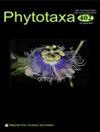Bryofloristic diversity and conservation value of a protected area in the Brazilian semi-arid region
IF 1
4区 生物学
Q3 PLANT SCIENCES
引用次数: 0
Abstract
We collected 137 samples (71—rainy season; 66—dry) for the Brazilian state of Paraíba. With a total of 23 species (one hornwort, 14 mosses and nine liverworts), we updated the bryoflora of Paraíba, a hotspot of bryophytes, by one rare species (Weissia controversa), increasing the total number of species to 188. The floristic composition in the Poeta e Repentista Juvenal de Oliveira State Park is affected by chronic anthropogenic disturbances, and is typical of arid environments, regardless of the season. This indicates homogenization of the habitat from the loss of ecological niche due to the disordered use of local natural resources. However, the record of Philonotis hastata, categorized as Near Threatened by the IUCN; the geographic expansion of a species; and the presence of rare species for Brazil reinforce the importance of the Conservation Unit for bryophyte biodiversity. Despite the floristic composition, we identified that interpretations about biology, environmental functionality and species distribution are more consistent for environmental assessment and decision-making on conservation actions.巴西半干旱地区一个保护区的植物多样性和保护价值
我们在巴西帕拉伊巴州采集了 137 个样本(71 个雨季样本;66 个旱季样本)。我们总共采集了 23 个物种(1 个角草、14 个苔藓和 9 个肝草),并增加了一个稀有物种(Weissia controversa),使帕拉伊巴州的植物区系增至 188 个。Poeta e Repentista Juvenal de Oliveira州立公园的植物组成受到长期人为干扰的影响,是典型的干旱环境,与季节无关。这表明,由于对当地自然资源的无序利用,生态位丧失,导致栖息地同质化。然而,Philonotis hastata 被世界自然保护联盟(IUCN)列为濒危物种;一个物种在地理上的扩展;以及巴西稀有物种的存在,都加强了该保护区对红叶植物生物多样性的重要性。尽管花卉构成不同,但我们发现,对生物学、环境功能和物种分布的解释在环境评估和保护行动决策方面更加一致。
本文章由计算机程序翻译,如有差异,请以英文原文为准。
求助全文
约1分钟内获得全文
求助全文
来源期刊

Phytotaxa
PLANT SCIENCES-
CiteScore
1.90
自引率
27.30%
发文量
956
审稿时长
1 months
期刊介绍:
Phytotaxa is a peer-reviewed, international journal for rapid publication of high quality papers on any aspect of systematic and taxonomic botany, with a preference for large taxonomic works such as monographs, floras, revisions and evolutionary studies and descriptions of new taxa. Phytotaxa covers all groups covered by the International Code of Nomenclature foralgae, fungi, and plants ICNafp (fungi, lichens, algae, diatoms, mosses, liverworts, hornworts, and vascular plants), both living and fossil. Phytotaxa was founded in 2009 as botanical sister journal to Zootaxa. It has a large editorial board, who are running this journal on a voluntary basis, and it is published by Magnolia Press (Auckland , New Zealand). It is also indexed by SCIE, JCR and Biosis.
All types of taxonomic, floristic and phytogeographic papers are considered, including theoretical papers and methodology, systematics and phylogeny, monographs, revisions and reviews, catalogues, biographies and bibliographies, history of botanical explorations, identification guides, floras, analyses of characters, phylogenetic studies and phytogeography, descriptions of taxa, typification and nomenclatural papers. Monographs and other long manuscripts (of 60 printed pages or more) can be published as books, which will receive an ISBN number as well as being part of the Phytotaxa series.
 求助内容:
求助内容: 应助结果提醒方式:
应助结果提醒方式:


